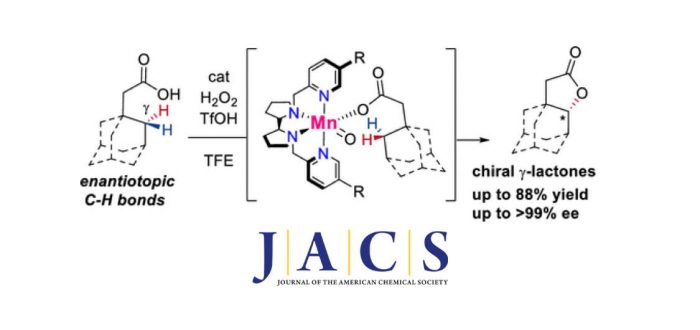The formidable challenges of controlling site-selectivity, enantioselectivity and product chemoselectivity, make asymmetric C-H oxidation a generally unsolved problem for non-enzymatic systems. Discrimination between the two enantiotopic C-H bonds of an unactivated methylenic group is particularly demanding and so far unprecedented, given the similarity between their environments and the facile overoxidation of the initially formed hydroxylation product. Here we show that a Mn-catalyzed C-H oxidation directed by carboxylic acids can overcome these challenges to yield γ-lactones in high enantiomeric excess (up to 99%) using hydrogen peroxide as oxidant and a Brønsted acid additive under mild conditions and short reaction times. Coordination of the carboxylic acid group to the bulky Mn complex ensures the rigidity needed for high enantioselectivi-ty and dictates the outstanding γ site-selectivity. When the substrate contains non-equivalent γ-methylenes, the site-selectivity for lactonization can be rationally predicted on the basis of simple C-H activation/deactivation effects exerted by proximal substituents. In addition, discrimination of diastereotopic C-H bonds can be modulated by catalyst design, with no erosion of enantiomeric excess. The potential of this reaction is illustrated in the concise synthesis of a tetrahydroxylated bicy-clo[3.3.1]nonane enabled by two key, sequential γ-C-H lactonizations, with the latter that fixes the chirality of five stereogenic centres in one step with 96% ee. The paper was published last week in Journal of the American Chemical Society.
M. Cianfanelli, G. Olivo, M. Milan, R.J.M. Klein Gebbink, X. Ribas, M. Bietti, and M. Costas
“Enantioselective C–H Lactonization of Unactivated Methylenes Directed by Carboxylic Acids”
J. Am. Chem. Soc. 2020, ASAP [abstract]
DOI: 10.1021/jacs.9b12239

